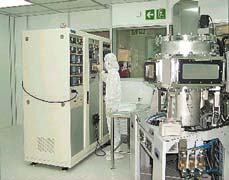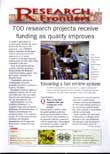 |
 |
||
 |
|||
| Clearer, brighter OLED colours (top left), LED colours (above left); and City U's cleanroom | |||
The small area flat
panel display industry in Hong Kong, which represents about 20 per cent
of the world market, could soon be getting a range of new frontier technology
as a result of research at CityU.
![]() As well as
developing new technologies behind organic light emitting diode (OLED)
displays, the university is looking at basic research involving organic
electronluminescence issues such as new materials, and new device structures,
interfaces, machanisms, efficiency and stability.
As well as
developing new technologies behind organic light emitting diode (OLED)
displays, the university is looking at basic research involving organic
electronluminescence issues such as new materials, and new device structures,
interfaces, machanisms, efficiency and stability.
![]() OLED displays
have a range of performance advantages over liquid crystal displays (LCDs),
including wider viewing angles, higher contrast, faster response time,
flexible panels, and potentially lower manufacturing costs. One research
project, completed in February, looked at good and undesirable properties
in the construction of OLEDs with the objective of increasing quality
and life-time.
OLED displays
have a range of performance advantages over liquid crystal displays (LCDs),
including wider viewing angles, higher contrast, faster response time,
flexible panels, and potentially lower manufacturing costs. One research
project, completed in February, looked at good and undesirable properties
in the construction of OLEDs with the objective of increasing quality
and life-time.
![]() "OLEDs
will potentially replace LCD display panel technology in many consumer
electronic products, from cellular phones and PDAs, to watches and computers,"
said Principal Investigator Prof Shuit-tong Lee from CityU's Department
of Physics and Materials Science.
"OLEDs
will potentially replace LCD display panel technology in many consumer
electronic products, from cellular phones and PDAs, to watches and computers,"
said Principal Investigator Prof Shuit-tong Lee from CityU's Department
of Physics and Materials Science.
![]() The research
came up with four significant discoveries: l That, because of the small
interaction between metal and organic molecules, energy level alignment
at the interfaces does not follow the common model of vacuum level alignment.
The research
came up with four significant discoveries: l That, because of the small
interaction between metal and organic molecules, energy level alignment
at the interfaces does not follow the common model of vacuum level alignment.
![]() That the presence
of the metallic element indium in organic layers increases drive voltage
and reduces luminescence efficiency.
That the presence
of the metallic element indium in organic layers increases drive voltage
and reduces luminescence efficiency.
![]() That, contrary
to common belief, devices prepared at high temperature to induce crystallization
of organic layers show considerable improvement in luminescent efficiency,
brightness, as well as storage stability in air, compared to devices prepared
at room temperature.
That, contrary
to common belief, devices prepared at high temperature to induce crystallization
of organic layers show considerable improvement in luminescent efficiency,
brightness, as well as storage stability in air, compared to devices prepared
at room temperature.
![]() That water is
the main cause of chemical reactions when thin films of organic semiconductors
are exposed to normal ambient conditions.
That water is
the main cause of chemical reactions when thin films of organic semiconductors
are exposed to normal ambient conditions.
![]() Prof Lee said:
"The results improve our understanding of the fundamental physics
involved in OLED which can lead to better design, enhanced performance,
as well as good operational and storage stability." Development in
OLED technology is forecast to increase the industry's worth from US$66
million this year to US$714 million in 2005, he added. CityU has established
itself as a pioneer in the development of OLED technology in Hong Kong
and Mainland China.
Prof Lee said:
"The results improve our understanding of the fundamental physics
involved in OLED which can lead to better design, enhanced performance,
as well as good operational and storage stability." Development in
OLED technology is forecast to increase the industry's worth from US$66
million this year to US$714 million in 2005, he added. CityU has established
itself as a pioneer in the development of OLED technology in Hong Kong
and Mainland China.
![]() To sustain
its status in the future, the university has added weight to broadening
its research from device optimisation to other areas such as the search
for new materials. An on-going project due for completion next February,
is looking at a number of important issues including new materials, material
/ interface characteristics, and the mechanisms of electroluminescence
efficiency and stability. Part of the research work has focused on the
shortcomings of a typical flourescent molecule, perylene.
To sustain
its status in the future, the university has added weight to broadening
its research from device optimisation to other areas such as the search
for new materials. An on-going project due for completion next February,
is looking at a number of important issues including new materials, material
/ interface characteristics, and the mechanisms of electroluminescence
efficiency and stability. Part of the research work has focused on the
shortcomings of a typical flourescent molecule, perylene.
![]() At low concentrations
perylene has a high flourescent yield. However, with higher concentrations,
its flourescent yield decreases. By adding chemical groups to convert
perylene into tetra-tert-butylperylene (TBPe), researchers believe they
have found a solution to the drop-off in flourescent yield.
At low concentrations
perylene has a high flourescent yield. However, with higher concentrations,
its flourescent yield decreases. By adding chemical groups to convert
perylene into tetra-tert-butylperylene (TBPe), researchers believe they
have found a solution to the drop-off in flourescent yield.
![]() The
improvement makes TBPe a better organic material for OLED applications.
Prof Lee said: "What this project will deliver will be a range of
sustainable frontier technology for the flat panel display industry in
Hong Kong, and possibly a new direction towards high performance electronic
devices."
The
improvement makes TBPe a better organic material for OLED applications.
Prof Lee said: "What this project will deliver will be a range of
sustainable frontier technology for the flat panel display industry in
Hong Kong, and possibly a new direction towards high performance electronic
devices."
